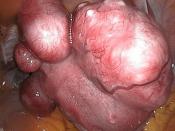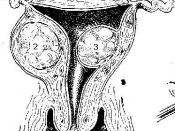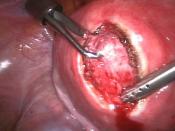Uterine Fibroids What are they? Uterine Fibroids are the most frequently diagnosed noncancerous tumors of the female pelvis. They are smooth muscle or connective muscle growths in the walls of the uterus. Sometimes, a fibroid is attached to the outside of the uterus by a stalk. Fibroids may grow as a single nodule or in clusters. They range in size from as small as a pea to as large as an orange or small melon. Sometimes fibroids grow large enough to fill the entire abdomen or pelvis.
What causes fibroids? The cause of fibroids is unknown. Fibroids are the most common in women ages 30-40, but they can develop at any age. An estimated 20-30% of all women develop fibroids. The female hormone estrogen seems to increase their growth. Fibroids may increase in size or appear during pregnancy because levels of estrogen are increased. Because estrogen levels fall during menopause, fibroids stabilize during this time.
Fibroids are diagnosed 2-3 times more frequently in black women than in white women.
What are the symptoms? Most fibroids do not produce any symptoms. When symptoms do occur, there is a large range including: Changes in the menstrual cycle increase in bleeding longer and more frequent periods cramping bleeding or spotting between periods amenia from blood loss Pain in the stomach or lower back which can range from dull to sharp during sex Pressure difficulty while urinating or an increase in frequency of urination constipation, rectal pain, or difficulty with a bowel movement felling of fullness in your lower abdomen Problems with pregnancy, labor, and delivery miscarriages trouble getting pregnant premature birth breech birth (baby's position is other than head down) How are they diagnosed? During a routine pelvic exam, your doctor may be able to detect the first signs of uterine fibroids. There...


